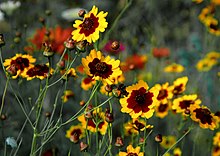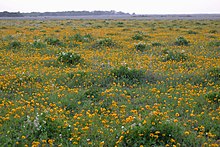| Plains coreopsis | |
|---|---|

| |
|
Scientific classification
| |
| Kingdom: | Plantae |
| Clade: | Tracheophytes |
| Clade: | Angiosperms |
| Clade: | Eudicots |
| Clade: | Asterids |
| Order: | Asterales |
| Family: | Asteraceae |
| Genus: | Coreopsis |
| Species: | C. tinctoria
|
| Binomial name | |
| Coreopsis tinctoria | |
| Synonyms [1] | |
|
Synonymy
| |
Plains coreopsis, garden tickseed, [2] golden tickseed, [3] or calliopsis, Coreopsis tinctoria, is an annual forb. The plant is common in Canada (from Quebec to British Columbia), northeast Mexico ( Coahuila, Nuevo León, Tamaulipas), and much of the United States, especially the Great Plains and Southern states where it is often called "calliopsis". [4] [5] The species is also widely cultivated and naturalized in China. [6]
It often grows in disturbed areas such as roadsides and cultivated fields. [7]
Description

Growing quickly, Coreopsis tinctoria attains heights of 30–100 cm (12–40 in). Its leaves are pinnately-divided, glabrous and tend to thin at the top of the plant where numerous 25–40 mm (1–1+1⁄2 in) flower heads sit atop slender stems. [8]
Flower heads are brilliant yellow with maroon or brown disc florets of various sizes. Flowering typically occurs in mid-summer. The small, slender seeds germinate in fall (overwintering as a low rosette) or early spring. [8] Ray florets have notched tips. Its native habitats include prairie, plains, meadows, pastures, savannas, roadsides, and pond banks. [9] The Latin specific epithet tinctoria refers to its use in dyeing. [10]
Ecology
Coreopsis tinctoria is pollinated by a wide variety of insects, including long-tongued bees, short-tongued bees, wasps, flies, butterflies and beetles. Coreopsis tinctoria serves as a larval host plant for various insects, such as Synchlora aerata, Tornos scolopacinarius and Calligrapha californica. [11]
Uses
The Zuni people traditionally use the blossoms of the tinctoria variety to make a mahogany red dye for yarn, [12] and, until the introduction of coffee by traders, to make a hot beverage. [13] Women also used an infusion of the whole plant of this variety, except for the root, if they desired a female child. [14]
Cultivation

Plains coreopsis is cultivated as an ornamental plant for gardens, and as a native plant for wildlife gardens and natural landscaping. It grows well in many types of soil, but seems to prefer sandy or well-drained loam soils. [15] Although somewhat drought-tolerant, naturally growing plants are usually found in areas with regular rainfall. Preferring full sun, it will also grow in partial shade. [16] Though plains coreopsis is often described as an annual some plants will behave more like biannuals growing larger and blooming more in their second year. [15]
- Cultivars
Because of its easy growing habits and the bright, showy flowers of cultivars such as 'Roulette' (tiger stripes of gold on a deep mahogany ground), plains coreopsis is increasingly used for landscape beautification and in flower gardens. [16]
References
- ^ The Plant List, Coreopsis tinctoria Nutt.
- ^ BSBI List 2007 (xls). Botanical Society of Britain and Ireland. Archived from the original (xls) on 2015-06-26. Retrieved 2014-10-17.
- ^ USDA, NRCS (n.d.). "Coreopsis tinctoria". The PLANTS Database (plants.usda.gov). Greensboro, North Carolina: National Plant Data Team. Retrieved 17 January 2016.
- ^ Biota of North America Program 2014 county distribution map
- ^ A biosystematic study of Coreopsis tinctoria and C. cardaminefolia (Compositae). Edwin B. Smith and Hampton M. Parker, Brittonia, Volume 23, Number 2, pages 161-170, doi: 10.2307/2805432
- ^ Flora of China, 两色金鸡菊 liang se jin ji ju Coreopsis tinctoria Nuttall
- ^ Everitt, J.H.; Lonard, R.L.; Little, C.R. (2007). Weeds in South Texas and Northern Mexico. Lubbock: Texas Tech University Press. ISBN 0-89672-614-2
- ^ a b Flora of North America, Coreopsis tinctoria Nuttall, J. Acad. Nat. Sci. Philadelphia. 2: 114. 1821.
- ^ "Lady Bird Johnson Wildflower Center - The University of Texas at Austin". www.wildflower.org. Retrieved 2022-01-01.
- ^ "Coreopsis tinctoria - Plant Finder". www.missouribotanicalgarden.org. Retrieved 2022-01-01.
- ^ "Plains Coreopsis". www.illinoiswildflowers.info. Retrieved 16 December 2023.
- ^ Stevenson, Matilda Coxe 1915 Ethnobotany of the Zuni Indians. SI-BAE Annual Report #30 (p.80)
- ^ Stevenson, p.66
- ^ Stevenson, p.84
- ^ a b Barr, Claude A. (1983). Jewels of the plains : wild flowers of the Great Plains grasslands and hills. Minneapolis: University of Minnesota Press. p. 62. ISBN 0-8166-1127-0.
- ^ a b Pink, A. (2004). Gardening for the Million. Project Gutenberg Literary Archive Foundation.
External links
-
 Media related to
Coreopsis tinctoria at Wikimedia Commons
Media related to
Coreopsis tinctoria at Wikimedia Commons -
 Data related to
Coreopsis tinctoria at Wikispecies
Data related to
Coreopsis tinctoria at Wikispecies - United States Department of Agriculture Plant Conservation Service: Coreopsis tinctoria
- Oklahoma State University, Forest & Pasture Management
